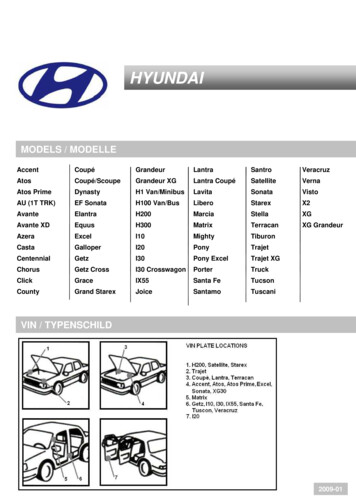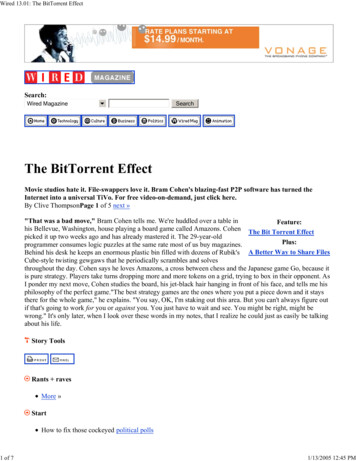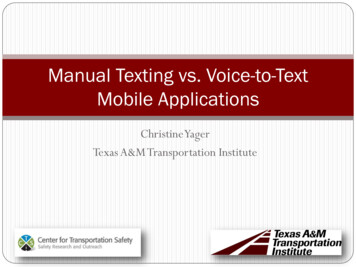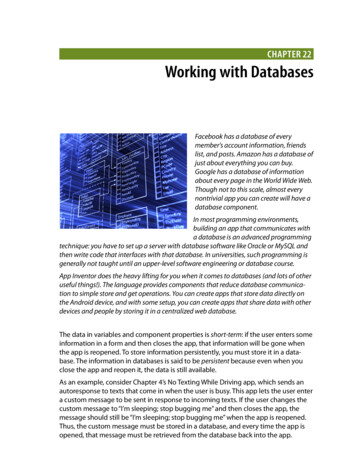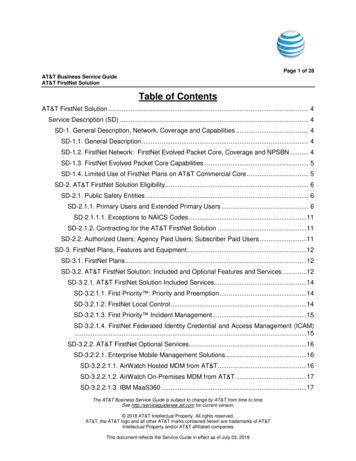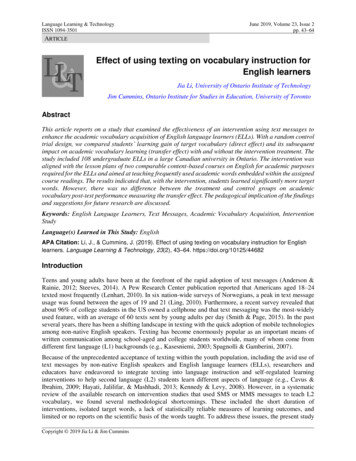
Transcription
Language Learning & TechnologyISSN 1094-3501June 2019, Volume 23, Issue 2pp. 43–64ARTICLEEffect of using texting on vocabulary instruction forEnglish learnersJia Li, University of Ontario Institute of TechnologyJim Cummins, Ontario Institute for Studies in Education, University of TorontoAbstractThis article reports on a study that examined the effectiveness of an intervention using text messages toenhance the academic vocabulary acquisition of English language learners (ELLs). With a random controltrial design, we compared students’ learning gain of target vocabulary (direct effect) and its subsequentimpact on academic vocabulary learning (transfer effect) with and without the intervention treatment. Thestudy included 108 undergraduate ELLs in a large Canadian university in Ontario. The intervention wasaligned with the lesson plans of two comparable content-based courses on English for academic purposesrequired for the ELLs and aimed at teaching frequently used academic words embedded within the assignedcourse readings. The results indicated that, with the intervention, students learned significantly more targetwords. However, there was no difference between the treatment and control groups on academicvocabulary post-test performance measuring the transfer effect. The pedagogical implication of the findingsand suggestions for future research are discussed.Keywords: English Language Learners, Text Messages, Academic Vocabulary Acquisition, InterventionStudyLanguage(s) Learned in This Study: EnglishAPA Citation: Li, J., & Cummins, J. (2019). Effect of using texting on vocabulary instruction for Englishlearners. Language Learning & Technology, 23(2), 43–64. https://doi.org/10125/44682IntroductionTeens and young adults have been at the forefront of the rapid adoption of text messages (Anderson &Rainie, 2012; Steeves, 2014). A Pew Research Center publication reported that Americans aged 18–24texted most frequently (Lenhart, 2010). In six nation-wide surveys of Norwegians, a peak in text messageusage was found between the ages of 19 and 21 (Ling, 2010). Furthermore, a recent survey revealed thatabout 96% of college students in the US owned a cellphone and that text messaging was the most-widelyused feature, with an average of 60 texts sent by young adults per day (Smith & Page, 2015). In the pastseveral years, there has been a shifting landscape in texting with the quick adoption of mobile technologiesamong non-native English speakers. Texting has become enormously popular as an important means ofwritten communication among school-aged and college students worldwide, many of whom come fromdifferent first language (L1) backgrounds (e.g., Kasesniemi, 2003; Spagnolli & Gamberini, 2007).Because of the unprecedented acceptance of texting within the youth population, including the avid use oftext messages by non-native English speakers and English language learners (ELLs), researchers andeducators have endeavored to integrate texting into language instruction and self-regulated learninginterventions to help second language (L2) students learn different aspects of language (e.g., Cavus &Ibrahim, 2009; Hayati, Jalilifar, & Mashhadi, 2013; Kennedy & Levy, 2008). However, in a systematicreview of the available research on intervention studies that used SMS or MMS messages to teach L2vocabulary, we found several methodological shortcomings. These included the short duration ofinterventions, isolated target words, a lack of statistically reliable measures of learning outcomes, andlimited or no reports on the scientific basis of the words taught. To address these issues, the present studyCopyright 2019 Jia Li & Jim Cummins
44Language Learning & Technologyexamined the effectiveness of an intervention that we developed to teach ELLs’ frequently used academicvocabulary—target vocabulary—within a learning context using text messages. In particular, it comparedELLs’ learning outcomes with and without the intervention treatment in target academic vocabularylearning (direct effect) and its subsequent impact on general academic vocabulary learning (transfer effect).Literature ReviewA growing body of empirical research has examined the effect of texting on vocabulary learning for Englishas a foreign language (EFL) learners at the high-school and university levels. In a thorough literature search,we located 16 experimental or quasi-experimental studies published from 2005 to 2016 in peer-reviewedjournals in English that examined the effect of SMS, MMS, or email messages via mobile phones onvocabulary or idiom learning. At a minimum, these studies included either (a) a pre-test and post-test forthe treatment group or (b) a post-test for both the treatment and control groups. Coincidently, all of the 16studies were conducted in EFL settings such as Japan, Hong Kong, Taiwan, Cyprus, China, Iran, Thailand,and Turkey (see Appendix). Except for the lab experiments of Chen, Hsieh, and Kinshuk (2008), 15 of the16 studies were intervention studies, most with a duration of two to four weeks. With the exception of thestudy of Thornton and Houser (2005), who taught students vocabulary on mobile phones using short emailmessages that were comparable to text messages, 15 of the 16 studies directly examined the effect of SMS(n 12) or MMS (n 3) messages on EFL students’ learning of English vocabulary (n 13) or idioms (n 2).The Effect of Texting-Based Instruction on L2 Vocabulary AcquisitionPrevious intervention studies indicated an overall positive trend of vocabulary gains using texting to supportEFL students’ vocabulary learning. Of the 15 intervention studies, 14 reported significant learning gainsafter the intervention using SMS, MMS or short email messages via mobile phone to support vocabularyor idiom learning. The only exception was a 7-week study conducted by Derakhshan and Kaivanpanah(2011) with Iranian freshman that reported no significant differences in students’ vocabulary gains betweenthe treatment and control groups. Of the 14 studies reporting learning gains, 13 showed significant results—direct effects—supporting texting- over paper- or web-based instruction. The only exception was the studyof Lin and Yu (2016) that compared the direct effect of messages with different text, audio, and visualcontent. There were two studies without control groups that showed significant gains in post-tests comparedwith their pre-tests (Cavus & Ibrahim, 2009; Song, 2008) and 11 studies that showed significant gains whencomparing the post-test or delayed post-test scores of treatment and control groups. In these studies, thecontrol groups often learned target words or idioms through paper materials or web-based learning activities(see Appendix). We were unable to locate any study examining transfer effects.In their previous work, our colleagues in EFL settings have taken the initiative and have provided muchinsight into this increasingly important area of texting-based instruction on L2 vocabulary acquisition. Theirresults, however, fail to reach a consensus on the effect of texting on L2 students’ vocabulary acquisitionthat is applicable to diverse L2 learners. In addition to the exclusive EFL contexts noted above, only eightexisting intervention studies clearly indicated participants’ proficiency levels, ranging from elementary tointermediate (see Appendix). The other studies made no explicit report on their participants’ proficiencylevels. There is an urgent need for studies to explore innovative instruction and learning support to helpyouth ELLs in English-speaking countries, as a large number of domestic and international learners ofEnglish with varied levels of language skills are avid text-users and encounter tremendous challenges inmeeting the requirements of academic English, including academic vocabulary knowledge (e.g., Douglas,2010).Most of the existing research is plagued by serious methodological shortcomings. The majority involves asmall and convenient sample size. Of the 15 intervention studies, only four clearly indicated the use ofrandomly assigned samples (Derakhshan & Kaivanpanah, 2011; Motallebzadeh & Ganjali, 2011;Motallebzadeh, Beh-Afarin, & Rad, 2011; Suwantarathip & Orawiwatnakul, 2015). The rest of the studies
Jia Li and Jim Cummins45either reported using convenient samples or did not report on the procedure for participant selection orgroup assignment. Of the 15 studies, 10 had a sample size under 50, including both treatment and controlgroups combined (see Appendix). Small sample sizes often decreased statistical power (i.e., the probabilityto correctly detect an intervention effect) and had an influence on the reliability of the results (Kline, 2004).Although all studies reported p values informing whether treatment effects existed, only one study (Hayatiet al., 2013) reported Cohen’s d measuring the magnitude of the standardized treatment effect (Wilkinson,1999). Moreover, these studies lacked reliable measures to establish baseline comparability betweentreatment and control groups in terms of variations in students’ language proficiency and other demographiccharacteristics (e.g., L1, age, gender, and duration of English instruction received). None of the 13intervention studies which included a control group reported the demographic comparability between thecontrol and treatment groups. Only four of the 10 studies which administered comparability measures onstudents’ language proficiency levels reported internal consistency reliability tests (Motallebzadeh &Ganjali, 2011; Motallebzadeh et al., 2011; Saran, Seferoğlu, & Çağıltay, 2012; Suwantarathip &Orawiwatnakul, 2015). Additionally, statistically rigorous measures to assess L2 learners’ learningoutcomes because of the texting-based intervention were also lacking. All of the 16 studies we reviewedemployed self-developed, mostly, multiple choice questions, and only six studies reported internalconsistency reliability indices for the tested items in the self-developed measures. Additionally, no studieswe reviewed reported inter-rater reliability tests for data coding consistency (see Appendix).Furthermore, previous results on the long-term effect of using texting-based instruction on word retentionappeared to be inconsistent. Only six of the 13 intervention studies with control groups administered bothpost-test and delayed post-tests. The delayed post-tests took place two to five weeks after the post-tests.One study reported significantly greater vocabulary gains on both post-tests and delayed post-tests,supporting MMS intervention over paper- and web-based instructional materials (Saran et al., 2012). Threereported significantly greater gains in delayed post-tests rather than post-tests, supporting either SMSintervention over self-paced learning using paper materials (Alemi, Sarab, & Lari, 2012; Zhang, Song, &Burston, 2011) or enriched content presentation in text messages (Lin & Yu, 2016). One reportedsignificantly greater gains in post-tests and not delayed post-tests, again supporting SMS intervention overpaper materials (Lu, 2008). Finally, one reported no differences in vocabulary gains between the controland treatment groups in either post-test or delayed post-test scores (Derakhshan & Kaivanpanah, 2011).Better results with delayed post-tests over post-tests might partly have been due to the short duration of theinterventions, low texting frequencies, or a combination of both.Lastly, we were unable to locate studies that investigated the transfer effect of vocabulary texting instructionon students’ learning of non-target words or other aspects of English knowledge (e.g., readingcomprehension skills). Previous studies measured only students’ learning gains in target words or idioms.The study with Iranian EFL adult learners by Motallebzadeh and Ganjali (2011) indicated significantlygreater gains on the total score of target words and reading comprehension, supporting the SMS intervention.However, separate scores on target words and reading were not reported, and there was no information onwhether the reading comprehension questions directly tested the usage of target words embedded in thereading or another aspect of reading comprehension, such as a possible transfer effect. Vocabularyinstruction needs to help students master a limited number of carefully selected “high leverage cross content”words (Lawrence, Crosson, Paré-Blagoev, & Snow, 2015, p. 5), so that they can become autonomouslearners capable of learning new words on their own—a transfer effect. As Biemiller points out, there is a“need for planned introduction and explanation of vocabulary plus various tools to help children becomemore independent in dealing with new vocabulary” (2001, p. 27). This is equally applicable to learners ofany age. It is critical to understand how much instruction and what type of instruction text messages candeliver to help L2 learners independently learn vocabulary beyond just target words.Major Intervention Design Features and Texting ContentA few key design features emerged from the intervention studies examining the effect of vocabularylearning using text messages. The majority of the interventions used the push model, a one-way
46Language Learning & Technologycommunication “where teachers [controlled] the frequency and the timing” (Stockwell, 2010, p. 96) as wellas the content of messages sent to learners. With three exceptions, the EFL learners sent their instructormessages with sentence construction, fill-in-the-blank, and writing exercises using target words andexchanged target word sentences with their peers (Derakhshan & Kaivanpanah, 2011; Suwantarathip &Orawiwatnakul, 2015; Tabatabaei & Goojani, 2012). Though students in some studies said they preferredtwo-way text messaging, interacting with their teachers and peers to create a more engaging andpersonalized learning experience (Cavus & Ibrahim, 2009), the push mode proved effective in providingstudents with a structured, practical, and convenient learning routine. This consistently enabled a small,viable amount of vocabulary knowledge input and led to significant learning gains, as was reported in theL2 reviewed intervention studies using the one-way communication push model. The push model can sendwell-designed “multicasting messages to a group of mobile users with a common profile, thereby improvingthe effectiveness and usefulness of the content delivered” (Motiwalla, 2007, p. 585). Moreover, it is easierto implement than two-way interactive texting among a large number of learners. It can also better ensurethe implementation fidelity of the interventions.Some of these studies’ intervention designs explicitly emphasized repeated exposures to target words,which conformed to a key instruction principle proven to be effective for L2 learners’ vocabularyacquisition (Hulstijn, 2001; Nation, 2001; Schmitt, 2008). For instance, Thornton and Houser (2005) sentJapanese university students three mini-lesson messages daily in multiple exposures: introducing a word,reviewing the word, and incorporating the word into a story. Cavus and Ibrahim (2009) divided 48 messagesinto three clusters of 16 messages and sent them to students three times over nine days.Frequent incremental vocabulary instruction (Barcroft, 2012) at spaced intervals (Braun & Rubin, 1998) isanother important cornerstone feature for some of the intervention designs. Of the 15 intervention studies,six sent student messages twice or more per day (see Appendix), often during the day time, when studentswere more receptive to text-based instruction. The highest texting frequency for spaced vocabularyinstruction was performed by Cavus and Ibrahim (2009) who sent their participants one email message viamobile phone, at a pre-determined optimal interval, every half hour between 9:00 a.m. and 5:00 p.m. In thestudy by Zhang et al. (2011), university students received two messages per day, one at 12:00 p.m. and theother at 5:30 p.m. Overall, these studies demonstrated the promise of texting to provide students withrepeated vocabulary exposures in structured and spaced intervals. This was more effective in supporting L2learning than “massed practice” (Seabrook, Brown, & Solity, 2005, p. 107); however, most of the studieswere missing information regarding the texting time and frequency.As to the content of text messages, the existing research seemed to be in agreement, focusing on teachingstudents word meanings by providing word definitions in English or the L1 and sample sentences—“discrete chunks readable on the tiny screens of mobile phones” (Thornton & Houser, 2005, p. 221). Thiswas not only feasible, but also effective, given that 13 of the 14 intervention studies with significant learninggains included definitions or sample sentences in their text messages. It is also worth noting that somestudies, to varying degrees, emphasized teaching target words in context (e.g., Song, 2008; Suwantarathip& Orawiwatnakul, 2015; Thornton & Houser, 2005). Song (2008) introduced students to new wordsthrough personal experiences in the UK on four topics (nightlife, food, weather, or travel). Each topiccovered four days’ learning content, focusing on four to six target words or expressions per day. A websitethat aimed to increase students’ exposure to target vocabulary also provided students with content resources,such as an online dictionary and vocabulary and cultural tips. Meanwhile, target words or expressions withbrief explanations in Chinese and English were sent to students through SMS. However, most interventionsin these studies taught words in a decontextualized and isolated manner, only providing sample sentencesand definitions in the L1 or English. This, in turn, diminished students’ repeated exposure to target wordsin context as well as their opportunities for further incidental learning of target and other words in authenticcontexts. It is reasonable to assume that if an intervention incorporates students’ other language learningactivities, directly supports classroom instruction, and teaches students words that meet their immediateneeds (e.g., assigned course readings), the intervention may effectively motivate students as well as bridgetheir attentive vocabulary learning through explicit instruction in various contexts.
Jia Li and Jim Cummins47Finally, among the studies we reviewed, the intervention with the longest treatment duration (16 weeks)had the lowest texting frequency (two messages per week; Alemi et al., 2012). The intervention with theshortest duration (nine days) had the highest texting frequency (16 messages per day with one messageevery 30 minutes; Cavus & Ibrahim, 2009). Other intervention studies had either a relatively short durationor low frequency of text messages, so they lacked an optimal combination of duration and frequency.Examples include two messages per week for four weeks (Lin & Yu, 2016), two messages per day for twoweeks (Lu, 2008), and four messages per day for 20 days (Hayati et al., 2013). According to research onlearning English as an L1, a single exposure to an unknown word results in a 10% to 15% chance of learningits meaning (see Nagy, Herman, & Anderson, 1985; Swanborn & Glopper, 1999). For L2 learners, moreexposure is required to acquire a word (Nation, 2001). Thus, limited treatment duration and textingfrequency may be insufficient for students to achieve long-term retention of target words—something thatwas not measured in most of the existing studies. The transfer effect (i.e., vocabulary learning gain beyondtarget words or in reading comprehension) has not been investigated.Research QuestionsThese studies have indicated the great potential of texting in facilitating EFL learners’ vocabulary and idiomlearning in a self-regulated format that can occur anytime, anywhere. However, beside the issues raisedabove regarding the research methods and intervention designs, previous EFL research has focusedexclusively on learners with low to intermediate English proficiency levels. In the present study, we triedto overcome these limitations and examined the effect of an intervention using texting on university ELLs’learning of contextualized academic vocabulary. These ELL students had an advanced-low languageproficiency level (American Council on the Teaching of Foreign Languages, 2012). The study answers thefollowing two research questions:1. What is the (direct) effect of the intervention using text messages on students’ learning of targetacademic vocabulary?2. What is the (transfer) effect of the intervention using text messages on students’ learning of general(non-target) academic vocabulary?MethodsUpon receiving ethics approval from two universities (one by the lead researcher’s affiliated university andthe other by the institution where the study was conducted), the students registered in six content-basedclasses of English for academic purposes (EAP) and their instructors at a large Canadian university inOntario were invited to participate in the study. The students were provided with an informational invitationletter about the project and a consent form with their instructors present. It was explicitly indicated thatstudent participation was voluntary and that they could withdraw from the study at any time and withoutany impact on their grades.ParticipantsParticipants included 108 (49% female) undergraduate students (ages 18–25) from the EAP classes. TheL1s spoken by the participants were Mandarin (51%), Cantonese (14%), Russian (7%), Arabic (7%), Farsi(7%), Korean (5%), Turkish (5%), Spanish (2%), and Lithuanian (1%). The duration of their residence inCanada varied from two months to 13 years (M 2.56 years, SD 2.90). The years of English instructionstudents had received previously ranged from two to 15 years (M 9.27 years, SD 3.57). The academicmajors of participants included economics, finance, business, accounting, computer science, biology,communication studies, psychology, actuarial science, English, law and society, and sociology. Based onthe university admission requirement for English language competence, the participants met therequirement at the lower end (i.e., 80 for the iBT, 6 for the IELTS) and often demonstrated difficultiesin reading comprehension of academic texts due to their limited academic vocabulary knowledge. It was achallenge to engage the class in meaningful discussions unless difficult academic words were explained insimpler English or in their L1s (e.g., Chinese, which a Chinese-English bilingual instructor was able to do).
48Language Learning & TechnologyConsequently, the students’ inability to support their arguments with well-integrated references andparaphrases created barriers to effective academic essay writing. Overall, their performance in the EAPprogram tended “to be uneven” (American Council on the Teaching of Foreign Languages, 2012, p. 6)across topics and language skills.The Intervention DesignThe intervention, Word Matters, aimed to teach university undergraduate English language learners “highleverage” (Lawrence et al., 2015, p. 5) academic words in their assigned readings using text messages. Itwas expected that this would increase their academic vocabulary knowledge, helping them approach thereading comprehension threshold required for an academic text (Nation, 2001)—familiarity with anestimated 95% of the vocabulary (Laufer & Ravenhorst-Kalovsk, 2010)—and, in turn, assisting theirlearning of other academic words encountered in academic texts.We used a randomized experimental design with pre-test and post-test data. The six classes, in whichparticipants were registered in two comparable EAP courses and taught by three instructors, were randomlyassigned to the treatment (n 48, 44.4%) and control groups (n 60, 55.5%), with three intact classes ineach group. The intervention lasted for nine weeks.As part of the curriculum of the courses, students in both treatment and control groups were required toread the same assigned readings and engage in class discussions of the readings with teachers’ instruction.Students in the control group were asked to use online dictionaries and dictionary apps with their owndevices to check the meanings of target words and sample sentences. This design aligned with the controlconditions in the studies previously discussed using dictionaries (e.g., Alemi et al., 2012) or web-basedmaterials (e.g., Saran et al., 2012; Thornton & Houser, 2005) and self-paced learning (e.g., Zhang et al.,2011). The control condition, which could be facilitated easily in class, combined instructors’ explanationsof words during class discussion with students learning the words by reading hard copies of articles or anovel. This condition was similar to the learning activities that often took place in the intact setting.The participants in the treatment group received an orientation email at the beginning of the projectexplaining the purpose of the intervention and the detailed information they would be receiving via textmessages. The intervention included sending students information about three words carefully selectedfrom the required reading materials each day through text messages: one at 10:00 a.m., one at 4:00 p.m.,and one at 8:00 p.m. Each text message included a target word, the title of the assigned reading where theword appeared, the page reference of the target word in the reading, the part of speech, the word’s definition,and a sample sentence (see Figure 1). Every evening at 8:30 p.m., students also received an email messagesummarizing the three words sent during the day and containing a small quiz on the words learned a weekbefore (see Excerpt 1). At the end of each week and month, the students received a downloadable summaryof the words they had been sent for their own future reference. During the nine week intervention, a totalof 189 target words were sent to students through text messages, with three words sent daily, or 21 wordsa week. Prior to the intervention, a trial text message and email message were sent to the students in thetreatment group who were required to confirm their receipt of the messages by texting and email. Studentsreported that on average they read three text messages four days a week in the post-intervention survey,which results are reported in a separate article focusing on students’ perceptions and experience of theintervention (Li, Cummins, & Deng, 2018).
Jia Li and Jim Cummins49Figure 1. Sample text messagesExcerpt 1. A Sample Daily EmailHello everyone,How are you doing today? It’s super cold in Boston these days and I believe it must be even colder inCanada.Keep warm, friends!Let’s see what we have for today:*principle* (from Crow Lake, p. 23)n. A rule that teaches you what is right and wrong and that influences your actions.It’s against my principles to cheat.*glean* (from Crow Lake, p. 23)v. To collect bit by bit.At present we’re gleaning information from all sources.*devotion* (from Crow Lake, p. 23)n. A feeling of strong love or loyalty.She has cared for the poor with selfless devotion.
50Language Learning & Technology quiz word game quiz word game quiz word game Do you still remember these words?Complete the following sentences with the words you learned last week. Write your answers on a pieceof paper and check tomorrow’s email for the answers!1. She claims that she can future events.2. If war broke out, it would be for the whole world.3. I would like to offer a historical .Answer for yesterday’s quiz: 1. abandon; 2. marvelous; 3. entangleHope you enjoy learning these words today!All the best,MeiData Collection ProcedureAll the participants in both the treatment and control groups were informed about the research procedures,including learning conditions, number of tests, test times, and length. One week before and after theintervention, both the treatment and control groups received a pre-test and post-test. To ensure accuratecomparable difficulty levels between the pre- and post-measures, the same vocabulary tests wereadministered. These included a 60-item target vocabulary test developed by the research team based on aselection of academic words from assigned readings that were texted to students during the intervention,and a 30-item (non-target) general academic vocabulary test adapted from the vocabulary levels test(academic level) by Schmitt, Schmitt, and Clapham (2001). All non-target words had appeared in assignedreadings. The participants were administered a pre-intervention survey that focused on their demographicsand technology use. A post-intervention survey and interviews were also conducted to collect informationon students’ learning behaviors during the intervention and their feedback on the intervention; those resultswere reported in a separate article (Li et al., 2018). The pre- and post-vocabulary tests and the preintervention survey were administered to the treatment and control groups in the classroom by the leadresearcher, a research assistant, or course instructors. Students were given 30–40 minutes to complete thepre-tests or post-tests. It took about 15–20 minutes for students to complete the surveys.Instrument DevelopmentPre-Intervention SurveyIn order to develop a feasible and effective intervention, we first developed a survey to identify technologyapplications that students often used and that were aligned with student interests or preferences. The surveyconsisted of two parts: Part 1 asked for demographic information (i.e., major, L1, years in Canada, countryof origin, years of English instruction) and Part 2 asked participants to report the frequency of theirtechnology use (i.e., email, text messaging, Facebook, Twitter, and other social media). The research teamdeveloped the survey in consultation with seven ELL students registered in the courses in the previous andcurrent school terms and three
A growing body of empirical research has examined the effect of texting on vocabulary learning for English as a foreign language (EFL) learners at the high-school and university levels. In a thorough literature search, we located 16 experimental or quasi-experime


